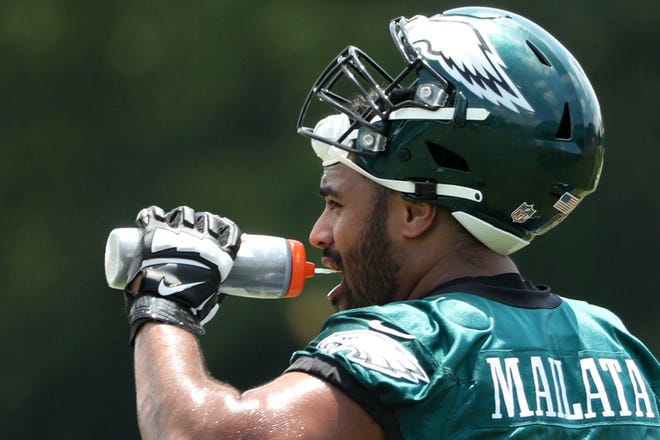There’s reason to think the Eagles can finish their quick rebuild and win big in '22

PHILADELPHIA — The Eagles reported Tuesday for training camp, and if you are of a certain age, you remember well the last offseason that they signed an elite, pass-rushing defensive end and traded for a game-changing wide receiver and created great expectations for themselves. That was a hell of a one-two punch back in March 2004. The news that the Eagles had agreed to an eight-year contract with Jevon Kearse wasn’t two weeks old, had barely begun to sink in, when they completed the unusual three-team deal to acquire Terrell Owens.
Of course, the similarities between that year’s team and this year’s pretty much end there. No one would suggest, at least not yet, that signing Haason Reddick and trading for A.J. Brown would put the 2022 Eagles on the same level as the 2004 Eagles. Not in terms of hype, and not in terms of quality.
More:‘An all-out new beginning’ for the Steelers
More:Some NFL training camp storylines you won’t see
More:Big Ten coaches relying heavily on revamped defenses
The buzz around that ‘04 team grew so fevered that 25,000 fans flocked to Lehigh University one Friday to attend and watch practice. Those were high times on the Northeast Extension of the Pa. Turnpike, and for good reason. The Eagles had reached the NFC Championship Game, and lost it, each of the previous three seasons. Owens and (to a lesser degree) Kearse were stars who were supposed to vault the team to the Super Bowl, and the plan would have worked if it hadn’t been for Brady, Belichick, and those meddling Patriots.
Even if this year’s Eagles don’t reach those heights, it’s worth comparing and contrasting ‘22 and ‘04 just for the manner in which each team came to be. When you consider how Andy Reid, Joe Banner, Tom Modrak, and the rest of the Eagles’ front office around that time assembled that roster, the difference between then and now — and the relative credit that Howie Roseman and his staff deserve for making these Eagles as formidable as they promise to be — becomes clear.
Take ‘04 first. Those Eagles were built gradually, the franchise making a steady, six-year climb from the awful, final season of Ray Rhodes’ tenure in 1998 to the best season of Reid’s. The key decision during that period, the move that made all that improvement possible, was the drafting of Donovan McNabb in 1999. In McNabb, the Eagles had a quarterback who could and would be the foundation of their team. And even after they signed him to a 12-year contract extension in 2002, they were able to construct a roster around him that, by 2004, had no significant weaknesses.
What’s fascinating about the Eagles now is that Jeffrey Lurie and Roseman had attempted to follow a similar formula, and the resulting concoction was a mixture of napalm and nitroglycerin. They drafted Carson Wentz, won a Super Bowl without him, signed him to a gigantic contract extension, got two full seasons out of him in five years, and traded him after they drafted Jalen Hurts and Wentz started pouting because they had. That 4-11-1 2020 season was as bad as it has been during the Lurie era, and it was made worse for the Eagles’ misreading of Wentz’s character and having to cut ties with him.
That the Eagles, just two years after that debacle, are expected to be one of the better teams in the NFC is evidence of two things. One, though Roseman’s ability to manipulate the Eagles’ salary-cap situation is generally regarded as his greatest strength as an executive, he has used the draft well, either in the players he has selected or the trades he has struck, to replenish the team’s talent pool. DeVonta Smith, Dallas Goedert, Jordan Mailata, Josh Sweat, Landon Dickerson, Quez Watkins, the picks that went to the Tennessee Titans in exchange for Brown: Dwell on Jalen Reagor and JJ Arcega-Whiteside if you want. Point out, fairly, that Hurts has plenty of questions that he has yet to answer. Roseman still put together a strong young core.
Two, if it falls into some good fortune and its power people make the right decisions, an NFL franchise doesn’t need a long time to rebuild. Draft the right quarterback (such as, say, Patrick Mahomes or Joe Burrow) or acquire the right collection of players in a given offseason (like the 2017 Eagles did), and presto: instant contender. This trend, born of the hard line of the salary cap and the league’s high rate of roster turnover, has been evident for years. Rather than look at an NFL team through the prism of a multiyear window, it’s better to view each season as its own self-contained entity. And the Eagles’ quick improvement from the end of the 2020 season to the beginning of this one demonstrates that even a major misfire on a prospective franchise quarterback isn’t necessarily crippling in the long term.
Few people thought about the 2004 Eagles in those terms. That team’s success was the culmination of years of tinkering and building and waiting, and had it failed to reach the Super Bowl, the disappointment here would have been profound, to put it mildly. Should this Eagles team reach the Super Bowl — and make no mistake, if Hurts plays well enough, it is capable of reaching the Super Bowl — it will be surprising, for sure. But only so much.